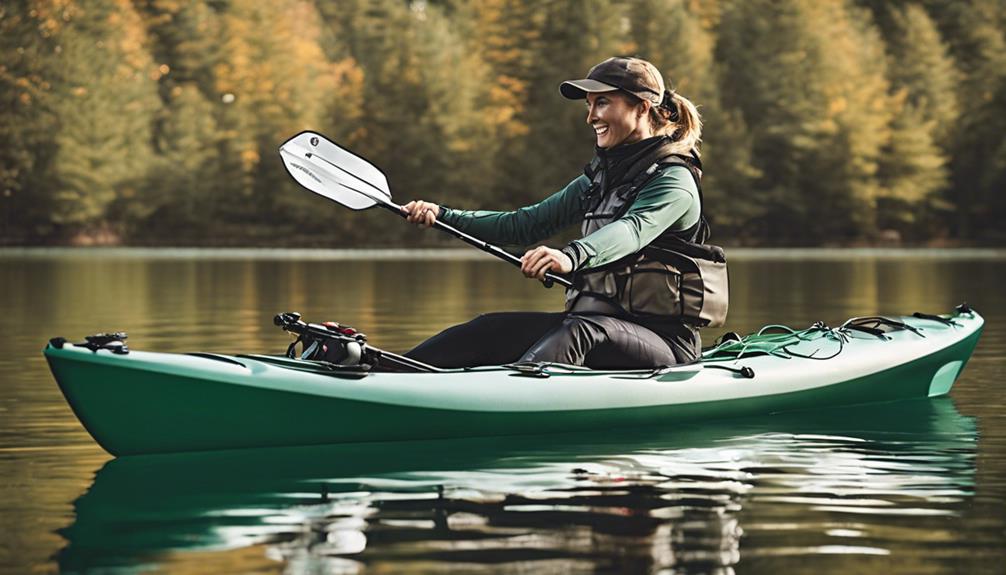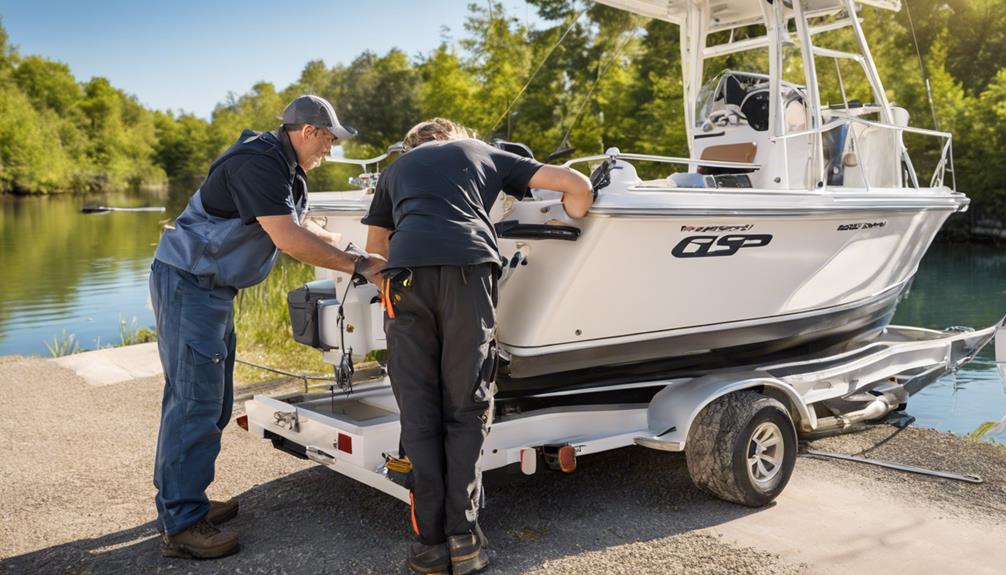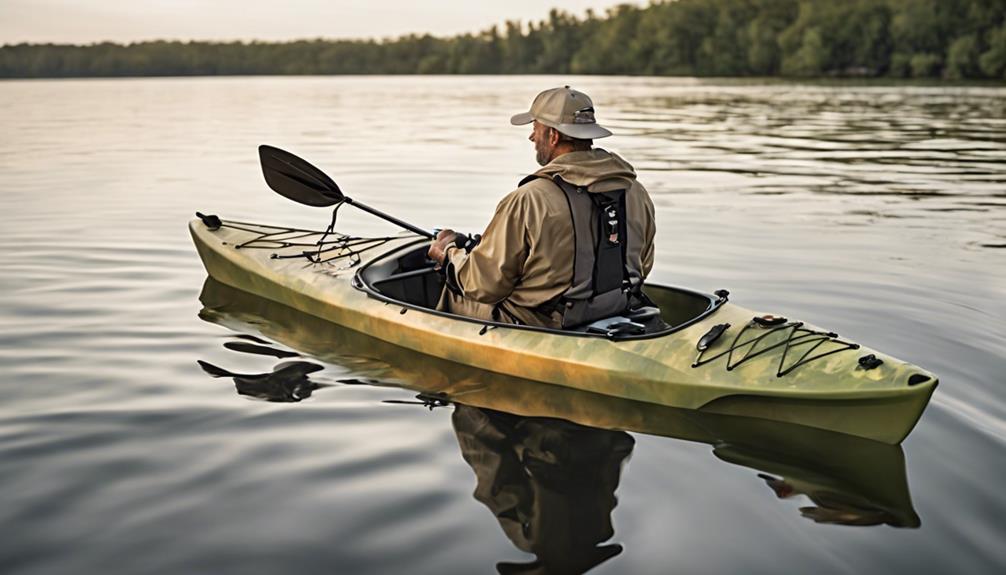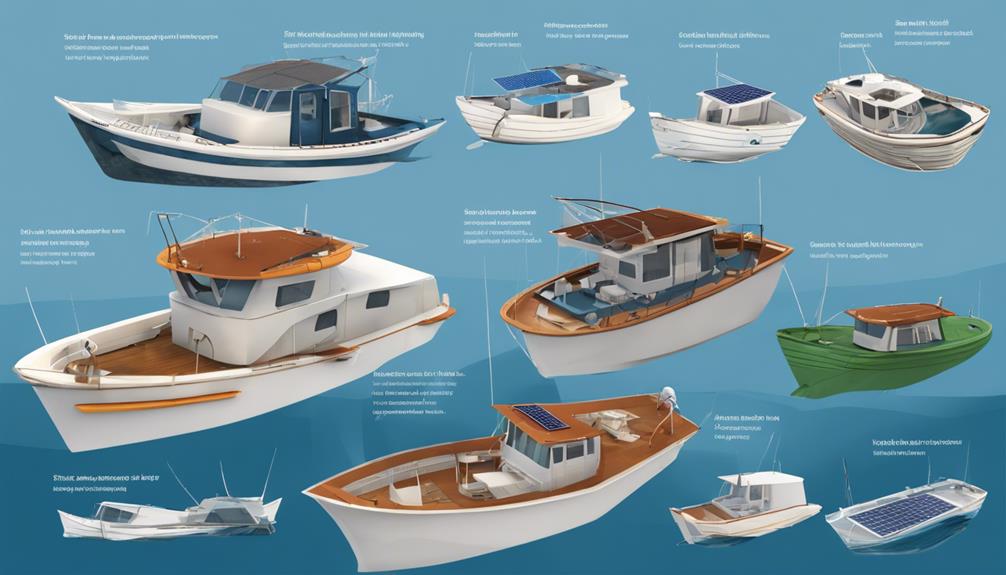Embarking on the journey to find the most stable fishing kayaks can be likened to navigating uncharted waters. Imagine the calm yet unpredictable nature of a serene lake as you ponder the key elements that ensure stability in your fishing vessel.
With various factors at play, from hull design to weight capacity, the quest for the perfect balance can be both intriguing and essential.
So, as you explore the intricacies of kayak stability, be prepared to uncover the secrets that will elevate your fishing experience to new heights.
Factors Affecting Kayak Stability
To understand what factors affect kayak stability, consider the weight distribution in relation to the kayak's design. The center of gravity plays a crucial role in how stable your kayak will be on the water. When the weight is evenly distributed, the center of gravity remains balanced, enhancing stability. However, if the weight is concentrated on one side, the center of gravity shifts, potentially leading to instability, especially in rough water conditions.
Water conditions also significantly impact kayak stability. In calm waters, it's easier to maintain balance and control over your kayak. However, in choppy or windy conditions, the stability of your kayak can be challenged. Waves and currents can cause the kayak to tip if not properly balanced, making it essential to adjust your weight distribution to adapt to changing water conditions.
Understanding these factors can help you choose a stable fishing kayak that suits your needs. By paying attention to the center of gravity and adjusting your weight distribution according to water conditions, you can ensure a more stable and enjoyable fishing experience. Keep these considerations in mind when selecting a kayak to maximize stability and minimize the risk of tipping over.
Importance of Hull Design
Considering the stability of fishing kayaks, the hull design plays a crucial role in determining how well the kayak performs on the water. The shape of the hull, along with the position of the center of gravity, greatly influences the stability of the kayak. Here are some key points to understand the importance of hull design:
- Hull Shape: The shape of the hull can be categorized into different types such as flat, pontoon, V-shaped, and tunnel hulls. Each hull shape affects stability differently based on the water conditions and your kayaking style.
- Center of Gravity: The position of your body and gear in relation to the center of gravity of the kayak is essential for stability. A lower center of gravity provides more stability by making the kayak less likely to tip over.
- Primary Stability: Hull designs with a wider beam generally offer higher primary stability, which is the initial stability felt when you first get into the kayak.
- Secondary Stability: Some hull designs prioritize secondary stability, which is the resistance to tipping once the kayak is leaned to one side. This can be crucial for experienced kayakers looking to maneuver in rough waters.
- Chine Design: The shape of the chine where the hull's bottom meets the sides also impacts stability. Hard chines provide better initial stability, while soft chines offer smoother transitions for leaning.
Understanding how hull design, including hull shape and center of gravity, affects the stability of fishing kayaks can help you choose the most suitable kayak for your needs.
Impact of Width on Stability
When determining the stability of a fishing kayak, the width of the hull significantly influences how balanced and steady the kayak feels on the water. The impact of width on stability is crucial when analyzing different kayak models. A wider kayak tends to provide more stability due to the increased surface area that comes into contact with the water. This greater width impact results in a kayak that's less likely to tip over, making it ideal for beginners or those looking for a more secure fishing experience.
In stability comparison, width variation plays a key role. Kayaks with wider hulls generally offer better initial stability, making them feel more secure when you're getting in and out of the kayak or moving around to access gear. However, it's important to note that wider kayaks may sacrifice some speed and maneuverability compared to narrower counterparts. Therefore, when choosing a fishing kayak, consider your priorities – whether you value stability above all else or are willing to trade off some stability for increased speed and agility on the water.
Ultimately, the width of a fishing kayak is a critical factor in determining its stability. By understanding the impact of width on stability and considering how different widths affect the kayak's performance, you can select a kayak that best suits your fishing style and preferences.
Role of Weight Capacity
The weight capacity of a fishing kayak directly impacts its performance and safety on the water. When considering weight capacity, factors such as weight distribution, stability, capacity, and balance play crucial roles in determining how well the kayak will handle different conditions:
- Weight Distribution: Proper weight distribution is essential for maintaining stability in a fishing kayak. Uneven weight distribution can cause the kayak to tilt to one side, affecting its balance and making it more prone to tipping over.
- Stability: A higher weight capacity often translates to greater stability on the water. Kayaks with higher weight capacities are generally more stable and can handle rougher waters with ease.
- Capacity: Exceeding the weight capacity of a kayak can compromise its performance and safety. It's important to adhere to the manufacturer's recommended weight limits to ensure a safe and enjoyable fishing experience.
- Balance: Maintaining a proper balance between the weight of the angler, gear, and the kayak itself is essential for stability. Balancing the load evenly will help prevent the kayak from listing to one side.
- Safety: Choosing a fishing kayak with an appropriate weight capacity isn't just about performance but also about safety. Overloading a kayak can increase the risk of capsizing, especially in challenging conditions.
Considering the weight capacity of a fishing kayak and understanding how it influences stability and balance is crucial for a safe and enjoyable fishing experience on the water.
Stability in Sit-In Vs. Sit-On-Top
Proper weight distribution plays a key role in determining the stability of both sit-in and sit-on-top fishing kayaks. When it comes to sit-in kayaks, the lower seating position helps to lower the center of gravity, enhancing stability. By having the paddler sit inside the kayak's hull, the weight is more centralized, which can contribute to better balance on the water.
In contrast, sit-on-top kayaks offer a different experience. These kayaks have a more open design, allowing for easier seat positioning and weight distribution. Although the center of gravity may be higher due to the raised seating, sit-on-top kayaks often have wider hulls, providing increased secondary stability.
The seat positioning in sit-in kayaks tends to be fixed, limiting the ability to adjust weight distribution compared to sit-on-top models where you can often move around more freely. This adjustability in sit-on-top kayaks can help you find the most comfortable and stable position according to your preference and the water conditions.
While sit-inside kayaks may offer a more enclosed and protected paddling experience, the versatility in weight distribution in sit-on-top kayaks can be advantageous for maintaining stability, especially for fishing purposes. Understanding how seat positioning and weight distribution impact the center of gravity and secondary stability is essential when selecting the most stable fishing kayak for your needs.
Benefits of Pontoon-Style Kayaks
For enhanced stability and maneuverability in fishing kayaks, consider the benefits of pontoon-style designs. Pontoon-style kayaks offer a range of advantages that make them a popular choice among anglers looking for a stable and safe fishing platform. Here are some key benefits to keep in mind:
- Increased Stability: Pontoon-style kayaks typically have a wider hull design, providing greater stability on the water. This stability is especially beneficial when casting lines or reeling in fish.
- Maneuverability Advantages: The dual-pontoon design of these kayaks allows for improved maneuverability, making it easier to navigate through different water conditions and tight fishing spots.
- Weight Capacity: Pontoon-style kayaks often have a higher weight capacity compared to traditional kayaks, allowing you to bring along more gear for your fishing expeditions.
- Comfort Features: Many pontoon-style kayaks come equipped with comfortable seating options, adjustable footrests, and ample storage space for all your fishing essentials.
- Safety Features: These kayaks are designed with safety in mind, featuring features such as multiple air chambers for added buoyancy, durable materials, and prominent visibility on the water.
Stability in Inflatable Kayaks
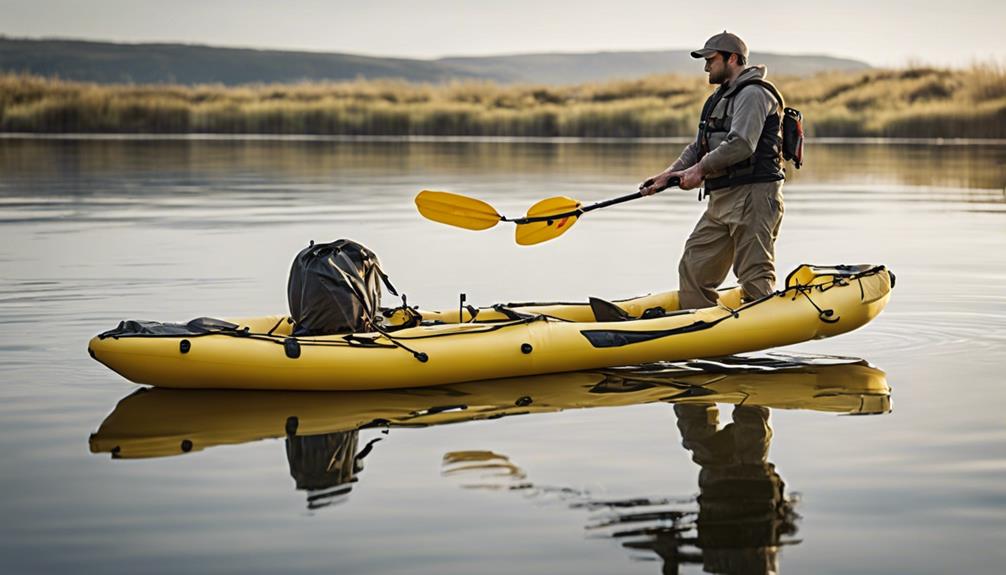
Consider the stability benefits of inflatable kayaks when seeking a versatile and portable fishing option. Inflatable kayaks have made significant advancements in terms of stability, making them a viable choice for fishing in various water conditions. When comparing inflatable vs. hardshell stability, inflatable kayaks are often designed with multiple air chambers that enhance their stability by providing increased buoyancy and balance. This design feature helps distribute weight more evenly, making them less prone to tipping over compared to traditional hardshell kayaks.
Stability in rough waters is a crucial factor to consider when choosing a fishing kayak. Inflatable kayaks are constructed using durable materials that can withstand challenging water conditions. The flexibility of the inflatable material allows the kayak to absorb impacts from waves, providing a more stable experience for the angler. Additionally, the inflatable design offers a level of shock absorption that can help navigate through choppy waters more comfortably than hardshell kayaks.
Comparing Stability in Different Brands
When comparing stability in different fishing kayak brands, focus on the design features that contribute to a secure and balanced experience on the water. Each brand incorporates unique elements into their kayaks that affect stability. To make an informed decision, consider the following:
- Hull Shape: Look for kayaks with a wider hull for increased stability.
- Weight Distribution: Brands vary in how they distribute the weight of the kayak, impacting stability.
- Material Quality: Different brands use various materials, affecting the overall stability of the kayak.
- Seat Design: The design of the seat can influence how stable you feel while fishing.
- Accessory Compatibility: Brands offer different accessory options that can impact the kayak's stability based on your needs.
When conducting a stability comparison, delve into the specifics of each brand's kayak models. Analyze how these factors play into the overall stability and balance of the kayak on the water. Through thorough brand analysis, you can determine which fishing kayak aligns best with your stability requirements. Remember, a stable kayak provides a safer and more enjoyable fishing experience, so choosing the right brand is crucial for your outings.
Frequently Asked Questions
Are Fishing Kayaks With Pedal Propulsion Systems More Stable Than Those With Traditional Paddle Propulsion Systems?
When comparing stability between fishing kayaks with pedal propulsion systems and those with traditional paddle systems, pedal kayaks tend to offer better stability due to their lower center of gravity.
To enhance stability further, focus on proper weight distribution by placing heavier gear closer to the kayak's center.
This will help keep you balanced and steady while out on the water, no matter which propulsion system you prefer.
How Does the Material of the Kayak, Such as Plastic, Fiberglass, or Carbon Fiber, Affect Its Stability on the Water?
When it comes to choosing a fishing kayak, the material it's made of plays a crucial role in its stability on the water. Different materials like plastic, fiberglass, or carbon fiber impact the kayak's durability, weight, and overall performance.
Plastic kayaks are durable and affordable, but heavier. Fiberglass kayaks are lightweight and offer good stability. Carbon fiber kayaks are top-notch in performance, being both lightweight and sturdy for an optimal fishing experience.
Can Adding Accessories Like Rod Holders, Fish Finders, or Coolers Affect the Stability of a Fishing Kayak?
Adding fishing kayak accessories like rod holders, fish finders, or coolers can affect stability. The weight and placement of these items can impact how your kayak handles on the water.
Coolers and rod holders can create additional weight and change the balance of your kayak, potentially affecting stability. It's important to consider how these accessories are attached and how they may shift while you're out fishing to maintain a stable experience.
Do Certain Weather Conditions, Such as Strong Winds or Choppy Waters, Impact the Stability of a Fishing Kayak More Than Others?
In rough weather, like strong winds or choppy waters, your fishing kayak's stability can be greatly affected. Wind impact can cause your kayak to sway and make it harder to maintain balance.
Similarly, choppy waters can create unpredictable movements, making it challenging to stay stable. To ensure a safe and enjoyable fishing experience in these conditions, consider your kayak's stability and make adjustments as needed.
Are There Specific Techniques or Tips for Maintaining Stability While Fishing From a Kayak, Such as Proper Weight Distribution or Adjusting Seating Positions?
To maintain stability when fishing from a kayak, remember these key tips. Proper posture and weight distribution are crucial for balance. Keep your center of gravity low and evenly distribute your weight to prevent tipping.
Sit upright and avoid sudden movements that could throw you off balance. By following these techniques, you can ensure a stable and enjoyable fishing experience on the water.
Conclusion
You've learned about the key factors that contribute to the stability of fishing kayaks.
From hull design to weight capacity, each aspect plays a crucial role in ensuring a smooth and secure fishing experience.
Whether you prefer sit-in or sit-on-top kayaks, understanding stability is essential for choosing the right model for your needs.
Consider the benefits of pontoon-style or inflatable kayaks for added stability on the water.
Now, go out and enjoy your fishing adventures with confidence in your stable kayak choice!
